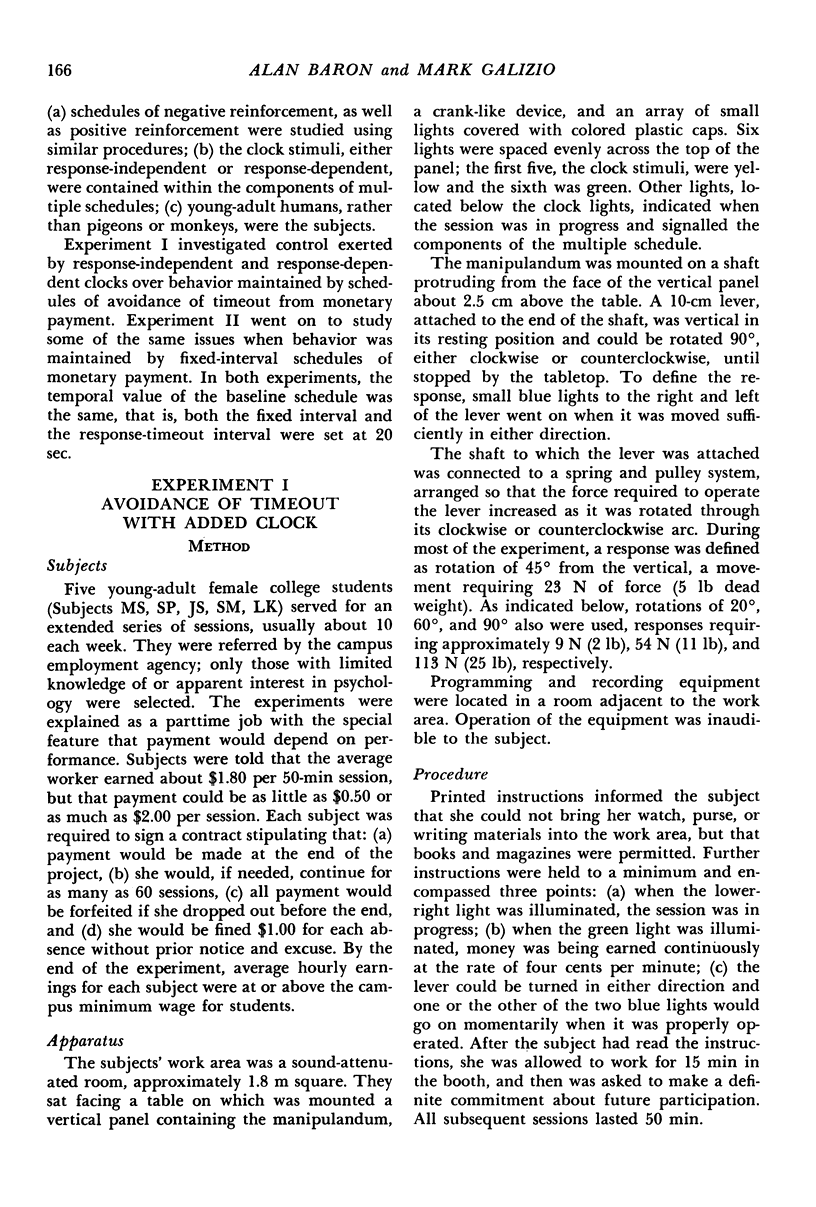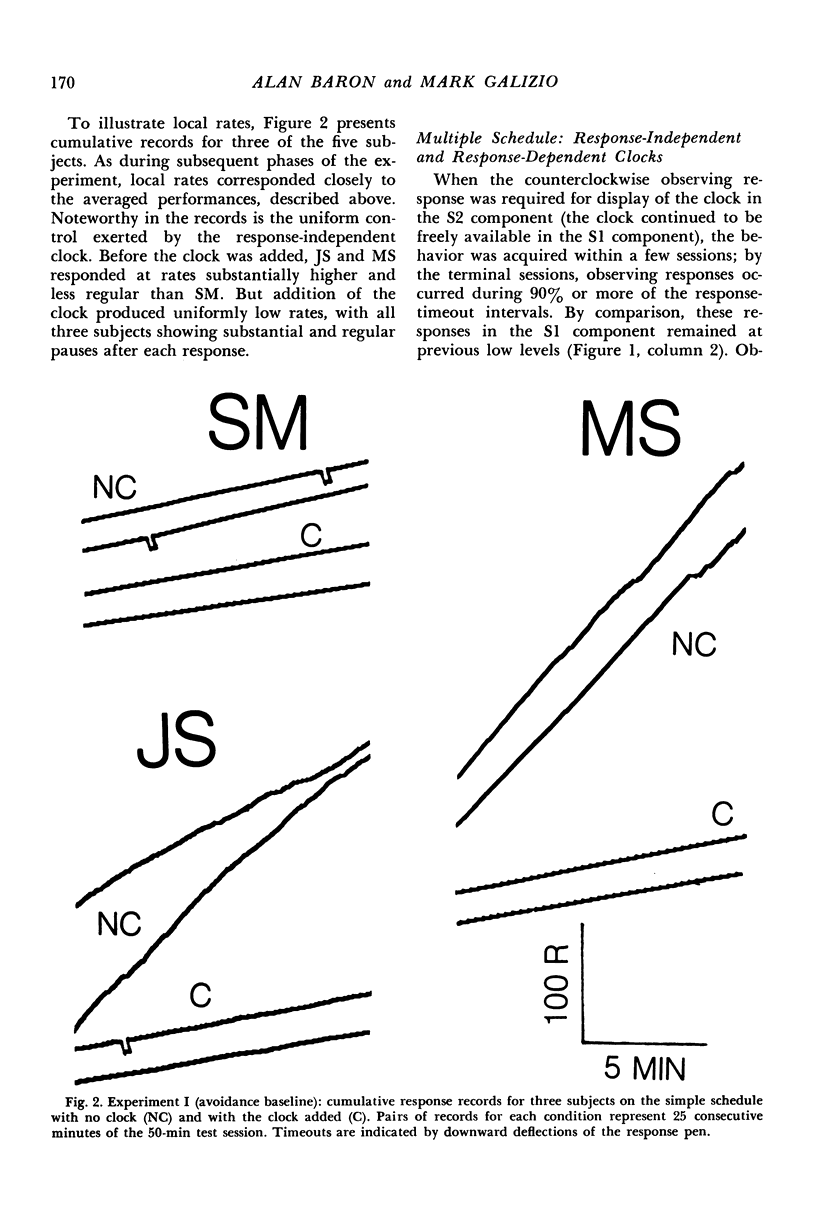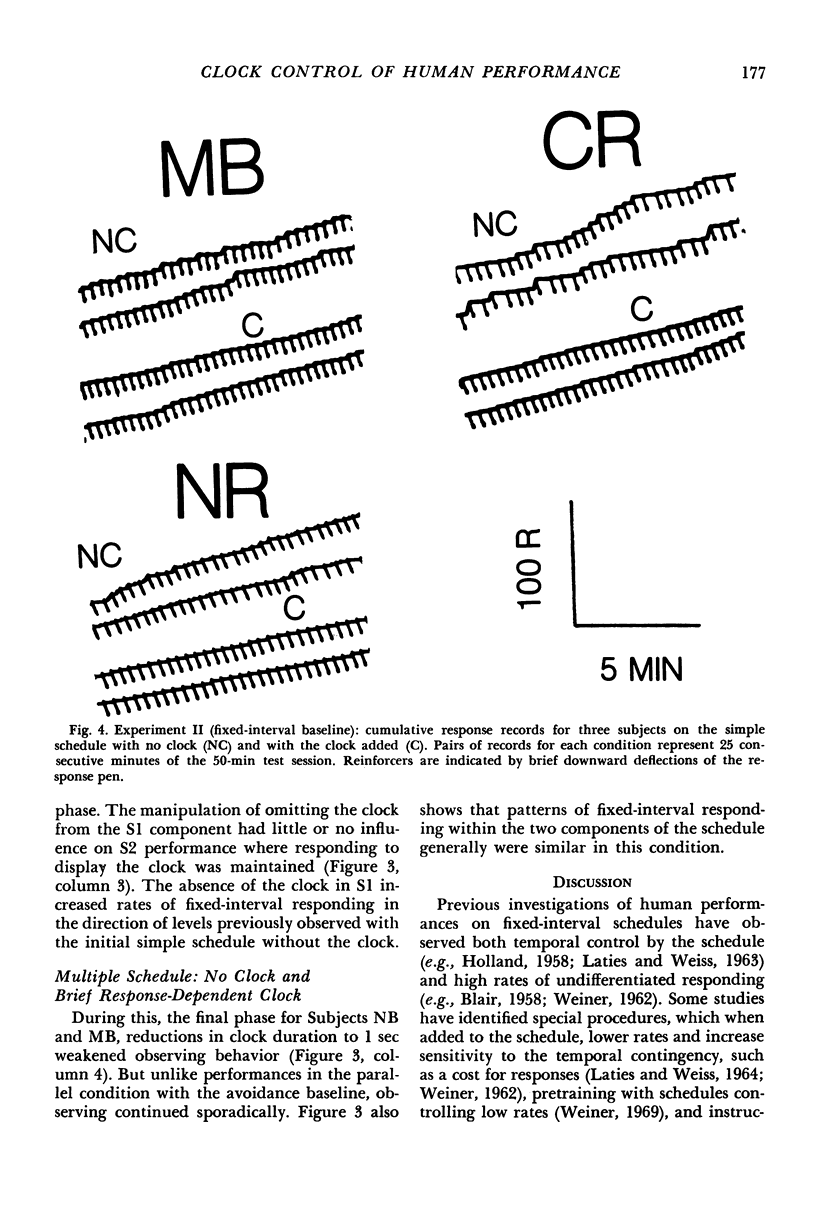Abstract
The avoidance and fixed-interval performances of human subjects were studied in two experiments. Addition of time-correlated stimuli (added clock) improved behavioral efficiency, since response rates decreased without decreases in reinforcement rates. Response-dependent display of the clock maintained a second, observing response and reductions in clock duration weakened such observing behavior. Generally, the reinforcing properties of the clock were more apparent with the avoidance than with the fixed-interval schedule, a finding attributed to temporal cues already provided by delivery of the fixed-interval reinforcers. Reduced rates of the main response when the clock was dependent on an observing response were more than offset by rates of the observing response in the majority of subjects. Thus, the results do not support an interpretation of the reinforcing properties of added clocks simply in terms of work reduction.
Keywords: clock, observing behavior, information, fixed-interval schedules, avoidance schedules, adult humans
Full text
PDF















Selected References
These references are in PubMed. This may not be the complete list of references from this article.
- Azrin N. H. Some Effects of Noise on Human Behavior. J Exp Anal Behav. 1958 Apr;1(2):183–200. doi: 10.1901/jeab.1958.1-183. [DOI] [PMC free article] [PubMed] [Google Scholar]
- BLAIR W. C. Measurement of observing responses in human monitoring. Science. 1958 Aug 1;128(3318):255–256. doi: 10.1126/science.128.3318.255. [DOI] [PubMed] [Google Scholar]
- Badia P., Culbertson S. A., Harsh J. Relative aversiveness of signaled vs. unsignaled avoidable and escapable shock situations in humans. J Comp Physiol Psychol. 1974 Aug;87(2):338–346. doi: 10.1037/h0036851. [DOI] [PubMed] [Google Scholar]
- Badia P., Culbertson S., Lewis P. The relative aversiveness of signalled vs unsignalled avoidance. J Exp Anal Behav. 1971 Jul;16(1):113–121. doi: 10.1901/jeab.1971.16-113. [DOI] [PMC free article] [PubMed] [Google Scholar]
- Baron A., Kaufman A. Facilitation and suppression of human loss-avoidance by signaled, unavoidable loss. J Exp Anal Behav. 1968 Mar;11(2):177–185. doi: 10.1901/jeab.1968.11-177. [DOI] [PMC free article] [PubMed] [Google Scholar]
- Baron A., Kaufman A. Human, free-operant avoidance of "time out" from monetary reinforcement. J Exp Anal Behav. 1966 Sep;9(5):557–565. doi: 10.1901/jeab.1966.9-557. [DOI] [PMC free article] [PubMed] [Google Scholar]
- Baron A., Kaufman A., Stauber K. A. Effects of instructions and reinforcement-feedback on human operant behavior maintained by fixed-interval reinforcement. J Exp Anal Behav. 1969 Sep;12(5):701–712. doi: 10.1901/jeab.1969.12-701. [DOI] [PMC free article] [PubMed] [Google Scholar]
- Grabowski J., Thompson T. Response patterning on an avoidance schedule as a function of time-correlated stimuli. J Exp Anal Behav. 1972 Nov;18(3):525–534. doi: 10.1901/jeab.1972.18-525. [DOI] [PMC free article] [PubMed] [Google Scholar]
- HOLLAND J. G. Human vigilance: the rate of observing an instrument is controlled by the schedule of signal detections. Science. 1958 Jul 11;128(3315):61–67. doi: 10.1126/science.128.3315.61. [DOI] [PubMed] [Google Scholar]
- Kendall S. B. Some effects of response-dependent clock stimuli in a fixed-interval schedule. J Exp Anal Behav. 1972 Mar;17(2):161–168. doi: 10.1901/jeab.1972.17-161. [DOI] [PMC free article] [PubMed] [Google Scholar]
- Laties V. G., Weiss B. Effects of a concurrent task on fixed-interval responding in humans. J Exp Anal Behav. 1963 Jul;6(3):431–436. doi: 10.1901/jeab.1963.6-431. [DOI] [PMC free article] [PubMed] [Google Scholar]
- Long E. R. Additional techniques for producing multiple-schedule control in children. J Exp Anal Behav. 1962 Oct;5(4):443–455. doi: 10.1901/jeab.1962.5-443. [DOI] [PMC free article] [PubMed] [Google Scholar]
- Segal E. F. Exteroceptive control of fixed-interval responding. J Exp Anal Behav. 1962 Jan;5(1):49–57. doi: 10.1901/jeab.1962.5-49. [DOI] [PMC free article] [PubMed] [Google Scholar]
- ULRICH R. E., HOLZ W. C., AZRIN N. H. STIMULUS CONTROL OF AVOIDANCE BEHAVIOR. J Exp Anal Behav. 1964 Mar;7:129–133. doi: 10.1901/jeab.1964.7-129. [DOI] [PMC free article] [PubMed] [Google Scholar]
- WEINER H. Some effects of response cost upon human operant behavior. J Exp Anal Behav. 1962 Apr;5:201–208. doi: 10.1901/jeab.1962.5-201. [DOI] [PMC free article] [PubMed] [Google Scholar]
- Weiner H. Controlling human fixed-interval performance. J Exp Anal Behav. 1969 May;12(3):349–373. doi: 10.1901/jeab.1969.12-349. [DOI] [PMC free article] [PubMed] [Google Scholar]


